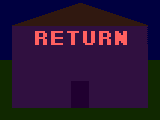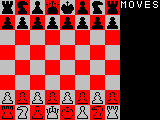
Random Colors
1. Introduction and needed items
This game is best played with two, three, or four players. The more players, the fewer the moves possible on each player. This game, hence it's name, deals with randomization. You need lots of Legos, however. You can buy a stash of 700 of the small ones in just about any of those department stores [? not sure; stores like Wal-mart and Target] for about 8 to 10 dollars. You can get any type/container as long as it comes with what is shown below in the needed items.
Needed items:
At least 50 Legos, 10 of 5 different colors [75, 15 of each of 5 colors recommended]; must be of the 2x4 size as shown in the diagram below
Something to draw the Legos out of like a box or a hat

2. How to play
With 2 or 3 players, form a base using the other Legos that come with the batch [the 2x2's and 1x2's in particular] so that the inside area is 12x12 [for four players, use 16x16]. Add 4 to find the outer perimeter of your base. These diagrams show you an example of both a 12x12 and a 16x16.

First, find a way to determine who goes first. Next, place all the Legos into the drawing container and mix 'em up. Let the player who goes first draw something out of the drawing container. Place this piece inside the base, not along the outer rim. This piece must first be placed along the corners facing any direction.
The next player then draws something again. He/she must place this piece next to the original, but the colors cannot match. If the piece drawn is an exact match to what was drawn by the first player, that player can put that piece back in the drawing hat and draw something else until a play can be made. This piece must be placed along the side of the existing piece in any way as long as they touch.
The next player must draw something as usual. As before, the pieces cannot be right next to each other when they're of the same color. They can, however, be at a diagonal.
Each player that follows continues to draw something and place it in the same fashion that:
- The pieces it is being joined to nearby must not be the color of the piece not being placed.
- The entire base gets filled [stacking on top can be done in any way.].
- When stacking, the piece being placed, along with rule number 1 above, must not have an "exposed corner" but it can be bridging a gap.
- When stacking, the piece must be placed along two or more other pieces, never on top of just one.
- Pieces can be stacked in any way, no matter how silly it gets. The sillier, the shorter the game and the harder it makes the other player have to think in order to do something.
3. How to win
Random colors is won when no other player can do anything. With 3 or more players, say, players 1, 2, and 3, this rule is a bit different. If a piece is placed by player 2 and player 3 draws something and can't do anything with that piece [except if it was the second move as with this case, the piece is put back and another is drawn], the player who made the last successful move wins unless player 1 figures out something that can be done with that piece. If so, player 3 is out of the game and it becomes a two-player game until no move can be made. The same goes with a four-player game.
Because this game only takes 5 to 10 minutes to complete, even with 3 or 4 players, it's recommended that you play a few rounds. Best of 5 rounds wins would be one of the best ways to play. Best of 3 rounds also works as good. Each time a player wins, they get one point. At the end of the 5 [or 3 or 7] rounds, the player with the most points is the winner.
Footnotes:
There are no footnotes for this page.








